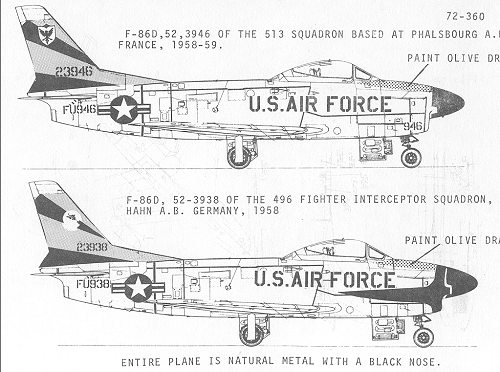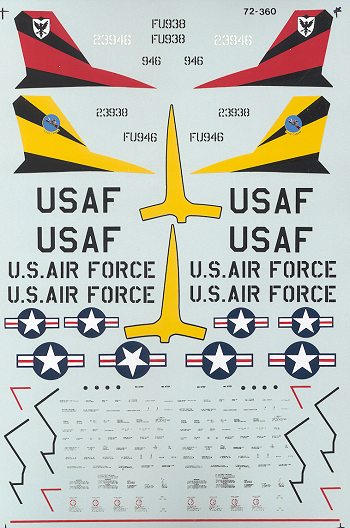
|
Sheet # |
Microscale 72-360 for F-86D Sabres |
|
Price: |
$6 |
|
Units: |
513 FIS and 496 FIS |
|
Review By: |
|
|
Notes: |

 This particular sheet is for the F-86D 'Sabre
Dog'. The F-86D was one of several aircraft developed specifically to intercept
incoming Soviet bombers. Like the F-89, F-94, it was decided to have all the
offensive armament as rockets, even though early versions of the others had gun
armament. It was felt that a volley of unguided missiles had the best chance of
knocking down a bomber. This is quite similar to late WW2 efforts of the
Luftwaffe and their R4M armed Me-262s.
This particular sheet is for the F-86D 'Sabre
Dog'. The F-86D was one of several aircraft developed specifically to intercept
incoming Soviet bombers. Like the F-89, F-94, it was decided to have all the
offensive armament as rockets, even though early versions of the others had gun
armament. It was felt that a volley of unguided missiles had the best chance of
knocking down a bomber. This is quite similar to late WW2 efforts of the
Luftwaffe and their R4M armed Me-262s.
Of the three, the F-86D was probably the better aircraft at medium altitudes. It had a good rate of climb and a reasonably good radar system, though none of the three had one that was well developed. The better aircraft at high altitude was the F-89 thanks to its large wing. The F-86D could reach altitudes of 40,000 feet or so, but maneuvering at that altitude often caused the aircraft to stall. The wide, non-swept wing of the F-89 was more efficient at those altitudes.
Despite that, so much emphasis was placed on bomber interception, that there were a huge number of F-86D squadrons throughout the US and in NATO countries. These units were generally very colorfully marked and these two are no exception.
The Microscale sheet offers two complete aircraft. It is undoubtedly designed for the elderly Airfix kit, but should fit the newer and much nicer Hasegawa 1/72 F-86D without too much trouble. Since this is the Microscale packaging, there is a full data placement chart given. However, it shows an F-86E/F so how useful it is to placement of decals is questionable. A good source for common data placement is the Ginter book on the F-86D as there are lots of closeup shots of the airframe in its pages.
The first unit is the 513th FIS at Phalsbourg AB in France 1958-59 just before the French withdrew from NATO and US forces left French soil. It is in standard markings with a black and red tail .
The other aircraft is from the 496th FIS at Hahn AB in Germany, 1958. This one has yellow and black tail markings as well as a nice yellow nose flash.
Both should make very nice models, especially when combined with the new Hasegawa kit.
If you would like your product reviewed fairly and quickly by a site that has over 1,000 visits a day, please contact me or see other details in the Note to Contributors.